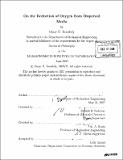On the reduction of oxygen from dispersed media
Author(s)
Roushdy, Omar H., 1977-
DownloadFull printable version (21.18Mb)
Alternative title
On the reduction of oxygen from dispersed medium
Other Contributors
Massachusetts Institute of Technology. Dept. of Mechanical Engineering.
Advisor
Donald R. Sadoway and Ain A. Sonin.
Terms of use
Metadata
Show full item recordAbstract
The reduction of oxygen from an organic phase dispersed in a concentrated electrolyte is investigated. Dispersed organic phases are used to enhance oxygen transport in fermenters and artificial blood substitutes. This work evaluates the feasibility of using a dispersed organic phase to transport oxygen in a fuel cell. An emulsion of perfluorohexane in a 20 wt% potassium hydroxide solution was formed with a lecithin surfactant. Oxygen was reduced from the emulsion on a rotating disk electrode. The dispersed phase did not contribute to the oxygen transport to the surface of a rotating disk electrode. An explanation is given based on the hydrodynamics of an emulsion under a rotating disk electrode. To eliminate the effect of hydrodynamics, the results of a hydrostatic transient diffusion experiment (Cottrell Experiment) are reported. Again, no significant enhancement of the oxygen transport rate was observed. The dispersed phase is shown to contain oxygen by NMR spectroscopy. It is argued that the expectation of an enhancement from the use of a dispersed phase may be based on inapplicable transport models. The presence of the lecithin surfactant may also impede transport. An oscillating electrode is used to reduce oxygen from a continuous perfluorohexane phase. In this case, the rate of reduction of oxygen is limited by diffusion across an aqueous layer trapped at the surface of the electrode by its relative affinity for aqueous solution over perfluorohexane. The implications for the use of a dispersed organic phase in fuel cells are discussed. The use of a rotating disk electrode in heterogeneous media and the need for a mass transport model in liquid-liquid dispersions are also discussed.
Description
Thesis (Ph. D.)--Massachusetts Institute of Technology, Dept. of Mechanical Engineering, 2007. Includes bibliographical references (p. 105-116).
Date issued
2007Department
Massachusetts Institute of Technology. Department of Mechanical EngineeringPublisher
Massachusetts Institute of Technology
Keywords
Mechanical Engineering.